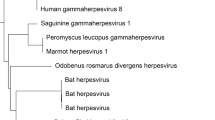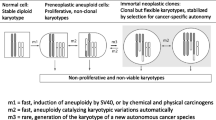Summary
Mouse cells with an established human cytomegalovirus (HCMV) infection were fused with susceptible human embryonic fibroblast cells. CMV-specific early antigens could be demonstrated in the cytoplasm and cell-membrane of the heterokaryons. Treatment with 5-iodo-2′-deoxyuridine (IUdR) of the heterokaryons or of the latently infected mouse cells, prior to their fusion with human cells, could induce the appearance of immunofluorescent elements, characterised as late antigens, and of infectious virus. Our data show that the mouse cells, in the latent stage of infection, contain the whole virus genome and that the replication of the virus is controlled by a genetic mechanism of the host cells both in virus-harbouring mouse cells and in heterokaryons.
Similar content being viewed by others
References
Albrecht, T., Rapp, F.: Malignant transformation of hamster embryo fibroblasts following exposure to ultraviolet-irradiated human cytomegalovirus. Virology55, 53–61 (1973).
Andersen, H. K.: Studies on human cytomegalovirus strain variations by kinetic neutralisation tests. Arch. ges. Virusforsch.38, 297–305 (1972).
Donner, L., Sainerova, H., Svoboda, J., Scherneck, S.: Potentiation of RSV rescue from RSV-transformed “poorly virogenic” cell lines by 5-bromodeoxy-uridine treatment before fusion with chick embryo fibroblast. Int. J. Cancer13, 37–42 (1974).
Gerber, P.: Activation of Epstein-Barr virus by 5-bromodeoxyuridine in “virus-free” human cells. Proc. Nat. Acad. Sci. U.S.A.69, 83–95 (1972).
Gerber, P., Hoyer, B. H.: Induction of cellular DNA synthesis in human leucocytes by Epstein-Barr virus. Nature (London) New Biol.231, 46–47 (1971).
Giraldo, G., Beth, E., Haguenau, F.: Herpestype virus particles in tissue culture of Kaposi's sarcoma from different geographic regions. J. Nat. Cancer Inst.49, 1509–1526 (1972).
Giraldo, G., Beth, E., Kourilsky, F. M., Henle, W., Henle, G., Mike, V., Huraux, J. M., Andersen, H. K., Gharbi, M. R., Kyalwazi, S. K., Puissant, A.: Antibody patterns to Herpesviruses in Kaposi's sarcoma: Serological association of European Kaposi's sarcoma with Cytomegalovirus. Int. J. Cancer15, 839–848 (1975).
Glaser, R., Rapp, F.: Rescue of Epstein-Barr virus from somatic cell hybrids of Burkitt lymphoblastoid cells. J. Virol.10, 288–296 (1972).
Glasgow, L. A., Hanshaw, J. B., Merigan, T. C., Petralli, J. K.: Interferon and cytomegalovirusin vivo andin vitro. Proc. Soc. exp. Biol. Med.125, 843–849 (1967).
Gönczöl, É., Boldogh, I., Váczi, L.: Virus specific changes in mouse cells inoculated with a strain of human cytomegalovirus. Acta microbiol. Acad. Sci. hung.22, 275–283 (1975).
Haguenau, F., Michelson-Fiske, S.: Cytomegalovirus: Nucleocapsid assembly and core structure. Intervirology5, 293–299 (1975).
Holmes, A. W., Gilson, J., Deinhardt, F.: Inhibition of interferon production by 5-iodo-2-deoxyuridine. Virology24, 229–232 (1964).
Osborn, J. E., Medearis, D. N., Jr.: Suppression of interferon and multiplication of Newcastle disease virus in cytomegalovirus infected mice. Proc. Soc. exp. Biol. Med.124, 347–353 (1967).
Rapp, F.: Herpesviruses and Cancer. Advan. Cancer Res.19, 265–302 (1974).
St. Jeor, S., Rapp, F.: Cytomegalovirus replication in cells pretreated with 5-iodo-2-deoxyuridine. J. Virol.11, 986–990 (1973).
St. Jeor, Rapp, F.: Cytomegalovirus: Conversion of nonpermissive cells to a permissive state for viral replication. Science181, 1060–1061 (1973).
St. Jeor, S., Albrecht, T. B., Funk, F., Rapp, F.: Stimulation of cellular DNA-synthesis by human cytomegalovirus. J. Virol.13, 353–362 (1974).
Svoboda, J., Hlozanek, I.: Role of cell association in virus infection and virus rescue. Adv. Cancer Res.13, 217–269 (1970).
Svoboda, J., Machala, O., Hlozanek, I.: Influence of Sendai virus on RSV formation in mixed cultures of virogenic mammalian cells and chicken fibroblasts. Folia biol.13, 155–161 (1967).
Takahashi, M., van Hoosier, G. L., Trentin, J. J.: Stimulation of DNA synthesis in human and hamster cells by human adenovirus types 12 and 5. Proc. Soc. exp. Biol. Med.122, 740–749 (1966).
Tanaka, S., Furukawa, T., Plotkin, S. A.: Human cytomegalovirus stimulates host cell RNA synthesis. J. Virol.15, 297–304 (1975).
Váczi, L., Gönczöl, É.: The effect of cytosine arabinoside on the multiplication of cytomegalovirus and on the formation of virus-induced intracellular antigens. Acta virol.17, 189–195 (1973).
Watkins, J. F., Dulbecco, R.: Production of SV-40 virus in heterokaryons of transformed and susceptible cells. Proc. Nat. Acad. Sci. U.S.58, 1396–1403 (1967).
Author information
Authors and Affiliations
Additional information
With 2 Figures
Rights and permissions
About this article
Cite this article
Boldogh, I., Gönczöl, É., Gärtner, L. et al. Expression of the human cytomegalovirus genome in mouse cells and in human-mouse heterokaryons. Archives of Virology 53, 101–108 (1977). https://doi.org/10.1007/BF01314851
Received:
Accepted:
Issue Date:
DOI: https://doi.org/10.1007/BF01314851




